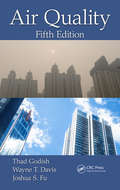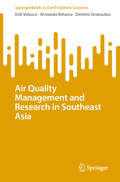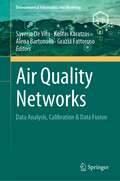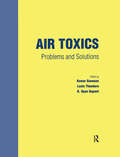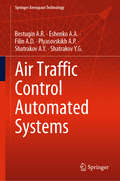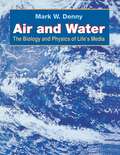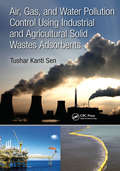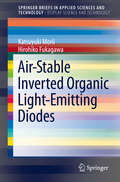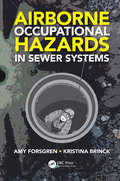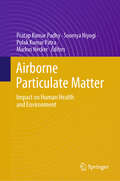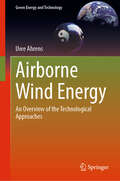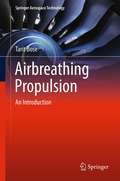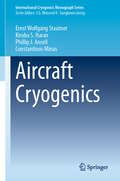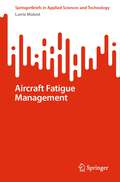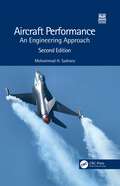- Table View
- List View
Air Quality
by Thad Godish Joshua S. Fu Wayne T. DavisThe fifth edition of a bestseller, Air Quality provides students with a comprehensive overview of air quality, the science that continues to provide a better understanding of atmospheric chemistry and its effects on public health and the environment, and the regulatory and technological management practices employed in achieving air quality goals.
Air Quality Management and Research in Southeast Asia (SpringerBriefs in Earth System Sciences)
by Erik Velasco Armando Retama Dimitris StratouliasThis book examines the capabilities for monitoring air quality, developing emission inventories, and running chemical-transport models for regulatory, forecasting, and research purposes in Southeast Asia. It also reviews scientific efforts made to better understand and characterize air pollution in the region. Poor air quality poses a threat to public health. It affects people's lives and undermines economic growth, but as in many other parts of the world, it has been overlooked in Southeast Asia. International assessments suggest that it is the culprit of 260-thousand premature deaths in the region each year, entailing a monetary cost equivalent to 6.75% of the regional GDP. Reducing air pollution requires concerted efforts from all Southeast Asian nations to implement local and regional air quality policies following a science-policy approach. For such endeavor, it is essential to develop tools that enable timely and reliable air quality management. This entails collecting data to characterize the magnitude, origin, and impact of air pollution to support corrective actions. The objective of this book is to provide a starting point for a science-based conversation about implementing solutions to Southeast Asia's air pollution problem by bringing together an analysis of the availability of air quality data and studies from across the region.
Air Quality Networks: Data Analysis, Calibration & Data Fusion (Environmental Informatics and Modeling)
by Kostas Karatzas Saverio De Vito Alena Bartonova Grazia FattorusoThis volume offers expert contributions proposing new and recently set scientific standards for smart air quality (AQ) networks data processing, along with results obtained during field deployments of pervasive and mobile systems. The book is divided into 5 main sections; 1) future air quality networks, 2) general data processing techniques, 3) field deployments performances, 4) special applications, and 5) cooperative and regulatory efforts. The authors offer different sources of data for the production of trustworthy insights, including spatio-temporal predictive AQ maps meant to boost citizen awareness, and informed participation in remediation and prevention policies. Readers will learn about the best and most up-to-date practices for measuring and assessing air quality, while also learning about current regulatory statuses regarding air quality technology design and implementation. The book will be of interest to air quality regulatory agencies, citizen science groups, city authorities, and researchers and students working with air quality sensors and geostatistics.
Air Quality and Human Health
by Markus Hecker Pratap Kumar Padhy Soumya Niyogi Pulak Kumar PatraThe book is one of the outcomes of the SPARC (Scheme for Promotion of Academic and Research Collaboration) project titled "Fine particulates matters in the air environment and their cancer risks in human beings," sponsored by MHRD (now MoE), Govt. of India. The editors of the book are PIs and Co-PIs of the said project. The text deliberates on air pollution's health risks with contributions from well-known experts from diverse research fields (environmental science, toxicology, geology, public health science, biology, physics, chemistry, and geospatial technology). It explores it its control and mitigation strategies. The book provides an up-to-date overview of the modern methods and tools used in air quality monitoring and human health risk assessment. Case studies from different global settings offer invaluable insights into air pollution-related regional health issues. It addresses all aspects of air quality, covering indoor-outdoor air pollution, gaseous and particulate pollutants; characterization of source and pathways of air pollutants; and the modeling and assessing of health risks (respiratory, epidemiological, and toxicological) with regional and global perspectives. It also addresses air quality management issues. The lucid explanation of the role of oxidative stress mechanisms and molecular biomarkers (genomics, proteomics) may be considered as inputs into the development of cancer therapeutics. Along with providing a scientific basis for air pollution, this book will help readers appreciate the environmental determinants of public health and apply research evidence to improve the quality of life. It also delineates future research initiatives and policy actions needed to protect human health from air pollution, locally and globally. The book will be of great educational value and help for consultation and teaching.
Air That Kills: India's Pollution Problem (Fountas & Pinnell Classroom, Guided Reading Grade 5)
by Susan StubbsTOXIC AIR In some Indian cities, people hurry through the streets, gasping for air. They have trouble breathing because of the air pollution, which is so bad that it can cause illness, and even death. NIMAC-sourced textbook
Air Toxics: Problems and Solutions
by Kumar GanesanThis timely new workbook is the result of a year-long effort by a group of university professors who first met at Montana Tech during the summer of 1994 for a college faculty workshop. The workshop was funded by the National Science Foundation's support for those faculty developing courses in the newly emerging field of air toxics. Part I of the book contains over 100 problems dealing with a variety of topics in this area. Part II provides detailed solutions. The problems and solutions provided will become a useful resource for the training of engineers and scientists who are or soon will be working in the field.
Air Traffic Control Automated Systems (Springer Aerospace Technology)
by Shatrakov A.Y. Shatrakov Y.G. Bestugin A.R. Eshenko A.A. Filin A.D. Plyasovskikh A.P.This book highlights operation principles for Air Traffic Control Automated Systems (ATCAS), new scientific directions in design and application of dispatching training simulators and parameters of ATCAS radio equipment items for aircraft positioning. This book is designed for specialists in air traffic control and navigation at a professional and scientific level. The following topics are also included in this book: personnel actions in emergency, including such unforeseen circumstances as communication failure, airplane wandering off course, unrecognized aircraft appearance in the air traffic service zone, aerial target interception, fuel draining, airborne collision avoidance system (ACAS) alarm, emergency stacking and volcanic ash cloud straight ahead.
Air and Water: The Biology and Physics of Life's Media
by Mark W. DennyAddressing general readers and biologists, Mark Denny shows how the physics of fluids (in this case, air and water) influences the often fantastic ways in which life forms adapt themselves to their terrestrial or aquatic "media."
Air and Weather
by Lawrence Hall of Science University of California at BerkeleyNIMAC-sourced textbook
Air and Weather
by Lawrence Hall of Science University of California at BerkeleyNIMAC-sourced textbook
Air, Gas, and Water Pollution Control Using Industrial and Agricultural Solid Wastes Adsorbents
by Tushar SenAir and water pollution occurs when toxic pollutants of varying kinds (organic, inorganic, radioactive and so on) are directly or indirectly discharged into the environment without adequate treatment to remove these potential pollutants. There are a total of 13 book chapters in three sections contributed by significant number of expert authors around the world, aiming to provide scientific knowledge and up-to-date development of various solid wastes based cost-effective adsorbent materials and its sustainable application in the removal of contaminates/pollutants from air, gas and water. This book is useful for the professions, practicing engineers, scientists, researchers, academics and undergraduate and post-graduate students’ interest on this specific area. Key Features: • Exclusive compilation of information on use of industrial and agricultural waste based adsorbents for air and water pollution abatement. • Explores utilization of industrial solid wastes in adsorptive purification and agricultural and agricultural by-products in separation and purification. • Discusses cost-effective solid wastes based emerging adsorbents. • Alternative adsorbents in the removal of a wide range of contaminants and pollutants from water is proposed. • Includes performance of unit operations in waste effluents treatment.
Air-Borne: The Hidden History of the Life We Breathe
by Carl ZimmerThe fascinating, untold story of the air we breathe, the hidden life it contains, and invisible dangers that can turn the world upside downEvery day we draw in two thousand gallons of air—and thousands of living things. From the ground to the stratosphere, the air teems with invisible life. This last great biological frontier remains so mysterious that it took over two years for scientists to finally agree that the Covid pandemic was caused by an airborne virus.In Air-Borne, award-winning New York Times columnist and author Carl Zimmer leads us on an odyssey through the living atmosphere and through the history of its discovery. We travel to the tops of mountain glaciers, where Louis Pasteur caught germs from the air, and follow Amelia Earhart and Charles Lindbergh above the clouds, where they conducted groundbreaking experiments. We meet the long-forgotten pioneers of aerobiology including William and Mildred Wells, who tried for decades to warn the world about airborne infections, only to die in obscurity.Air-Borne chronicles the dark side of aerobiology with gripping accounts of how the United States and the Soviet Union clandestinely built arsenals of airborne biological weapons designed to spread anthrax, smallpox, and an array of other pathogens. Air-Borne also leaves readers looking at the world with new eyes—as a place where the oceans and forests loft trillions of cells into the air, where microbes eat clouds, and where life soars thousands of miles on the wind.Weaving together gripping history with the latest reporting on Covid and other threats to global health, Air-Borne surprises us on every page as it reveals the hidden world of the air.
Air-Stable Inverted Organic Light-Emitting Diodes (SpringerBriefs in Applied Sciences and Technology)
by Katsuyuki Morii Hirohiko FukagawaThis concise volume provides an introduction to the working principles, design, and construction of air-stable inverted organic light-emitting diodes (OLEDs), which lead to the realization of practical flexible electronics. The first part of the book reviews the history of the three generations of inverted OLEDs: hybrid organic inorganic light-emitting diodes (HOILEDs), metal oxides and organic electron injection layer, describing the materials, fabrication techniques, device structure, applications, and technological challenges involved in each case. The second part of the book focuses on the carrier injection mechanism in OLEDs.The book will be of interest to students and researchers working on organic optoelectronics.
Airborne Biocontaminants and their Impact on Human Health
by Rajeev Singh Anamika SinghExplore in-depth the relationships between biological contaminants and human health found in diverse settings such as homes, hospitals, businesses, and schools Indoor air quality has an immense impact on human health and well-being. Indoor air environments can contain a huge range of biological contaminants, including bacteria, fungi, viruses, insects, and their various harmful byproducts. Indoor biocontamination has been under-studied as an aspect of public and occupational health, and there is an urgent need for an introduction to this vital subject. Airborne Biocontaminants and Their Impact on Human Health meets this need with a thorough, rigorous overview of major indoor airborne contaminants. Gathering and summarizing a huge range of data regarding biocontaminants in settings from homes to schools to workplaces, it investigates patterns of morbidity and their connections to major contaminants. The result is an essential tool in the broader fight for human health at home and elsewhere. Airborne Biocontaminants and Their Impact on Human Health readers will also find: Analysis of the indoor role of gases, particulate matter, and others Detailed coverage of contaminant byproducts including endotoxins, mycotoxins, volatile organic compounds, and more Methods for generating awareness and therefore reduced risk of exposure to harmful contaminants Airborne Biocontaminants and Their Impact on Human Health is ideal for researchers—biologists, environmentalists, civil and environmental engineers, industrial hygienists, safety regulators, and public health officials—interested in the area of biological contamination in different environments.
Airborne Occupational Hazards in Sewer Systems
by Amy Forsgren Kristina BrinckSewer systems fall into the category "out of sight, out of mind" – they seldom excite interest. But when things go wrong with the air in the sewer system, they go very wrong. Consequences can be dramatic and devastating: sewer workers killed instantly by poisonous gas when they lift a sewer lid, or entire suburban blocks levelled by explosions. This book describes the atmospheric dangers commonly found in the sewer system. It provides easily-understood explanations of the science behind the hazards, combined with real-life examples of when things went dramatically wrong.
Airborne Particulate Matter: Impact on Human Health and Environment
by Markus Hecker Pratap Kumar Padhy Soumya Niyogi Pulak Kumar PatraParticulate matter (PM) in the ambient air is a key indicator of air pollution. It can be suspended over long time and travel over a long distance in the atmosphere. It can cause a wide range of diseases that lead to a significant reduction of human life. Because of the potent role of PM and its associated pollutants, detailed knowledge of their effects on the environment in general, and human health in particular, is of primary importance. This book provides an in-depth overview of monitoring of airborne particulates and their sources and transport. The dynamics of nutrients, intake pathways of particulates by human body and other components of environment, and their possible health hazards and effects at different levels and at various organs are discussed. With contributions from well-known experts from diverse research fields, including medical and public health science professions, this book provides an exhaustive information on the health risks of air pollution and explores its control and mitigation strategies. In addition to providing a scientific basis for particulate air pollution, this book will also help readers, researchers and public health professionals to appreciate the environmental determinants of public health and apply research evidence for improving the quality of life. This will also delineate future research initiatives and policy actions needed with more stringent strategies for protecting the environment in general and human health in particular from PM at local, regional, and global levels.
Airborne Particulate Matter: Source, Chemistry and Health
by Anuradha Shukla Saurabh SonwaniThis book is about airborne particulate matter, sources, chemistry and health and contained a complete information about their emission source, transport, atmospheric chemistry, distribution at local, regional and global levels, and their level in indoor and outdoor settings. Primary and secondary particulate matters in the ambient atmosphere also describe in detail. Analytical techniques, statistical tools and mathematical models used in airborne particulate research is also described. This book also covers the important aspects of the particulate matter chemistry in atmosphere, and their adverse impact on plant and human health. A detailed insight about the harmful impact of airborne particulate matter (biogenic and anthropogenic both) on different human system is described in detail. The toxicological significance of particulate matter on human body was also mentioned. The mitigation, management and regulatory policies to control ambient particulate matter is also provided. This book is also written in simple language with helpful photographs, diagrams, tables and flowcharts which will make the reader comfortable in understanding the concepts a more relatively easier way. Overall, the present book is a valuable tool for students working in the fields of Atmospheric Science, Environmental Science, Biological Sciences, Epidemiology and Agriculture Science. This book also a unique resource for environmental consultants, researchers, policymakers and other professionals involved in air quality, plant and human health.
Airborne Wind Energy: An Overview of the Technological Approaches (Green Energy and Technology)
by Uwe AhrensThis book shows possible solutions to how a profitable energy supply can be implemented with almost no population resistance. Worldwide, more than 80 % of our energy needs are still covered by fossil fuels. Under these circumstances, can climate change still be stopped? Essential technologies for usage of wind energy with an emphasis on high-altitude wind utilization are presented. Airborne wind energy is one of the most promising technologies to enable a renewable energy turnaround in an economical way. The main problem of conventional renewable energy is the insufficient availability. To ensure a 100 % supply of renewable energy, enormous and very expensive storage capacities would have to be built up. How we can cover our entire energy needs (electricity, mobility and heat) in the future without fossil fuels, without risking the competitiveness of our economy, is shown in this book.
Airbreathing Propulsion: An Introduction (Springer Aerospace Technology)
by Tarit BoseAirbreathing Propulsion covers the physics of combustion, fluid and thermo-dynamics, and structural mechanics of airbreathing engines, including piston, turboprop, turbojet, turbofan, and ramjet engines. End-of-chapter exercises allow the reader to practice the fundamental concepts behind airbreathing propulsion, and the included PAGIC computer code will help the reader to examine the relationships between the performance parameters of different engines. Large amounts of data have on many different piston, turbojet, and turboprop engines have been compiled for this book and are included as an appendix. This textbook is ideal for senior undergraduate and graduate students studying aeronautical engineering, aerospace engineering, and mechanical engineering.
Aircraft Cryogenics (International Cryogenics Monograph Series)
by Ernst Wolfgang Stautner Kiruba S. Haran Phillip J. Ansell Constantinos MinasThis book gives a step-by-step approach to the design of a cryogenic infrastructure required for superconducting, all-electric aircraft systems which is also partially applicable to liquid hydrogen fueled subsonic and hypersonic aircraft, as well as hybrids. While there is no shortage of publications on hydrogen fueled aircraft, this book puts the past journal literature through a magnifying glass and condenses it into an engineering strategy for the next steps to enable liquid hydrogen storage and distribution in aircraft. Emphasis is placed on tank design, manufacturability, safety features, and minimum tank weight, providing a holistic focus on the logistics of hydrogen management for all major components within the aircraft as well as on future superconducting motor architecture. The intention is to fully exploit the benefits of a liquid hydrogen reservoir without any need for additional cryogenic fluids, with relevance to cooling of various superconducting components e.g., motors and superconducting cables, as well as the heat sinking of power electronics and for fueling the fuel cell stack system. A liquid hydrogen tank hold-time analysis reveals the main governing factors and describes the required efforts for minimizing onboard boil off for aircraft designs with different flight mission duration. This is followed by an outlook showing where cryotankage technology and cryogenic aircraft architecture may move within the next 20 years embedded in a green hydrogen-based economy and how basic research will need to play a major role to help us realizing these future designs by consequently eliminating whitespace within today's technology landscape. This book is also an aircraft engineering resource on composites, hydrogen properties, general aircraft materials and safety.
Aircraft Design (Springer Aerospace Technology)
by Mikhail A. PogosyanThis book presents general design methods of manned and unmanned aircraft for various types and purposes, as well as the problems of designing their structural and functional elements, based on the principles of a systematic approach and the achievements of modern information technologies. It reflects modern achievements in aircraft engineering, theory and methods of designing aircraft of various types, including aerospace, unmanned aerial vehicles and seaplane aircraft. The first part details the general theory, and the second part covers the engineering of components. This textbook will be used for students enrolled in undergraduate and graduate programs, and can also be useful to engineers and scientists dealing with aircraft design problems, as well as anyone who wants to independently study modern methods of aircraft design.
Aircraft Fatigue Management (SpringerBriefs in Applied Sciences and Technology)
by Lorrie MolentFatigue occurs under cyclic loading and can significantly degrade the operational capability and safety of metallic aircraft components and structures. This book provides summaries of some metallic aircraft structural integrity issues, innovative but established examples of maintaining operational capability—airworthiness, and assessments of safe in-service fatigue lives. These topics are based on a through-life fatigue management philosophy that ensures safe and continued operation, including during life extensions that are almost inevitably required. This philosophy is underpinned by observations of the behaviour of fatigue cracks in actual structures subjected to realistic service loading conditions. The book includes topics like aircraft design requirements, individual aircraft fatigue loads monitoring, airframe fatigue testing, sources of fatigue-nucleating discontinuities, and prediction of fatigue crack growth from these discontinuities. All these aspects contribute to discussing methods of assuring the structural integrity and operational capability of realistically cracked structures. The book also discusses the exponential behaviour of lead or dominant cracks—those leading to first failure—and the practical significance of differences between fatigue fracture topographies produced under constant amplitude and variable amplitude loading. The book can be a valuable reference for researchers and professionals interested in aircraft fatigue management and allied fields.
Aircraft Performance: An Engineering Approach
by Mohammad H. SadraeyAircraft Performance: An Engineering Approach introduces flight performance analysis techniques that enable readers to determine performance and flight capabilities of aircraft. Flight performance analysis for prop-driven and jet aircraft is explored, supported by examples and illustrations, many in full color. MATLAB programming for performance analysis is included, and coverage of modern aircraft types is emphasized. The text builds a strong foundation for advanced coursework in aircraft design and performance analysis.
Aircraft Performance: An Engineering Approach
by Mohammad H. SadraeyAircraft Performance: An Engineering Approach, Second Edition introduces flight performance analysis techniques of fixed-wing air vehicles, particularly heavier-than-aircraft. It covers maximum speed, absolute ceiling, rate of climb, range, endurance, turn performance, and takeoff run.Enabling the reader to analyze the performance and flight capabilities of an aircraft by utilizing only the aircraft weight data, geometry, and engine characteristics, this book covers the flight performance analysis for both propeller-driven and jet aircraft. The second edition features new content on vertical takeoff and landing, UAV launch, UAV recovery, use of rocket engine as the main engine, range for electric aircraft, electric engine, endurance for electric aircraft, gliding flight, pull-up, and climb-turn. In addition, this book includes end-of-chapter problems, MATLAB® code and examples, and case studies to enhance and reinforce student understanding.This book is intended for senior undergraduate aerospace students taking courses in Aircraft Performance, Flight Dynamics, and Flight Mechanics.Instructors will be able to utilize an updated Solutions Manual and Figure Slides for their course.
